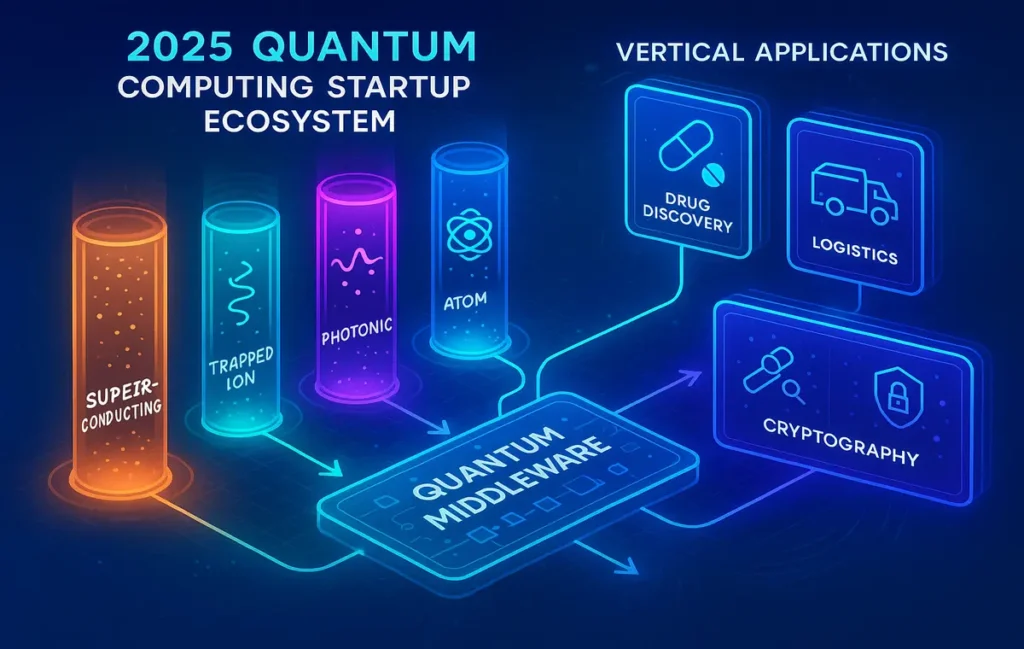🚀 Intro: From Lab Curiosity to Venture-Backed Contenders
For years, quantum computing lived in white papers and lab demos—important, fascinating, but distant. That framing no longer fits. In 2025 a distinct startup ecosystem has taken shape around hardware modalities, middleware stacks, and application layers built for near-term advantage. We’re past “could this work?” and squarely in “which path to scale, which markets first, and who captures value?” If you already track our posts like Quantum Computing 101 and Quantum Computing: How It Could Change Tech, think of this piece as the market layer that ties technology to traction. From early photonic bets to neutral-atom dark horses, from sovereign grants to strategic acquisitions, the story is no longer only science; it’s company building. At NerdChips, we see the same leading indicators we saw in AI a decade ago: better tools, cheaper iteration, and founders converging around real customer pain.
💡 Nerd Tip: Treat quantum like an industry stack, not a monolith. You’re evaluating hardware, control software, error mitigation, and domain apps—each can support venture-scale companies.
🔭 Why Quantum, Why Now?
A credible startup wave needs more than hype. Three forces are aligning. First, hardware reliability has inched forward: longer coherence, cleaner gates, and more predictable calibration cycles. We’re still far from fully error-corrected “fault-tolerant” machines, but better error mitigation and circuit transpilation have opened a lane for practical experimentation. Second, capital has found quantum’s rhythm. Generalist VCs are partnering with deeptech specialists; governments and sovereign funds are underwriting critical infrastructure. Third, demand has become less abstract. Teams in pharma, advanced materials, logistics, and finance aren’t buying “quantum dreams,” they’re buying even a few percent improvement on problems classical methods struggle with—portfolio risk under constraints, catalytic pathway search, or hard routing at scale.
The implication is subtle but powerful: we don’t need perfect quantum to start creating value. The next 24 months belong to hybrid approaches—clever combinations of classical compute, approximate methods, and small-but-useful quantum circuits. If you’ve read Top 10 Futuristic Tech Trends to Watch, you know this pattern: real markets open when a frontier tech plugs into familiar workflows. Quantum is beginning to do exactly that.
💡 Nerd Tip: Replace the binary “quantum is ready/not ready” with a gradient of QAP—Quantum Advantage Probability—by use case. Your thesis becomes sharper instantly.
🧩 The Modality Map: How Startups Differ Under the Hood
Quantum hardware isn’t one thing; it’s a zoo. The most useful way to understand the startup landscape is by modality—the physical way qubits are built and controlled. Four categories dominate headlines, each with distinct trade-offs for scale, fidelity, and manufacturability.
🧪 Side-by-Side Modality Snapshot
| Modality | Scale Path | Strengths | Constraints | Notable Startup Focus |
|---|---|---|---|---|
| Superconducting | Fabricated on silicon with Josephson junctions; fast gates | Mature toolchain, strong ecosystem, good integration with existing cryo & control stacks | Cryogenics, cross-talk at scale, complex wiring | Rigetti targeting modular chips; several stealth teams refining error mitigation |
| Trapped Ions | Ions trapped in EM fields; laser-driven gates | High-fidelity gates, identical qubits, strong stability | Laser complexity, gate speeds slower than superconducting | IonQ pursuing trapped-ion systems with cloud access and application partners |
| Photonic | Qubits as single photons; room-temp components | Room-temperature potential, telecom integration, manufacturability vision | Deterministic photon sources, loss management, error correction still tough | PsiQuantum with aggressive fab partnerships; UK/Canada players like Xanadu |
| Neutral Atoms | Arrays of cold atoms with Rydberg interactions | Promising scaling with atom arrays, flexible connectivity | Control precision, error rates still a focus, specialized expertise | Pasqal and QuEra driving analog/digital-analog hybrids for optimization |
No modality is a silver bullet. The most durable companies are honest about trade-offs—and build around them. Some pursue error-corrected dreams with long roadmaps; others go after NISQ (near-term) value, often bundling software and services to solve customer problems before raw hardware advantage is obvious.
💡 Nerd Tip: Ask founders, “What’s your error story?” If it’s only “we’ll wait for fault tolerance,” push deeper. Strong teams describe mitigation today and correction tomorrow.
🧭 Notable Quantum Startups in 2025 (Hardware & Beyond)
PsiQuantum (photonic): The photonics thesis centers on manufacturability—building at scale with existing semiconductor fabs and room-temperature optics. The company’s bet is long-range: build toward error-corrected machines with massive photonic circuits. Their traction signal is less about customer logos today and more about industrial partnerships and facility investments that shrink the path to millions of stable qubits.
IonQ (trapped ions): Public-market visibility aside, the interesting bit is application co-development. IonQ has consistently pushed cloud access and partnered on domain pilots—portfolio optimization, feature selection, and sparse machine learning—where hybrid workflows shine. Their story is “high-fidelity qubits now, scale steadily.”
Rigetti (superconducting): Rigetti’s modular strategy matters. Rather than chasing monolithic scale, they emphasize chiplet-style approaches, improved control electronics, and better calibration automation. The short-term wedge is faster iteration for developers via cloud APIs and tight integration with open-source toolchains.
Quantinuum (hybrid): Born from Honeywell’s quantum unit and Cambridge Quantum, Quantinuum pairs hardware with a software stack that includes error mitigation, cryptography tools, and—importantly—domain libraries. The dual strategy (devices + middleware) is a hedge and a moat: even as hardware matures, software layers can capture enduring value.
Rising Europe & Asia cohort:
-
Pasqal (France) & QuEra (US): Neutral-atom leaders, leaning into analog/digital-analog simulation—compelling for materials and optimization.
-
Xanadu (Canada): Photonic focus with strong software contributions (PennyLane) that keep developers engaged.
-
IQM (Finland): Superconducting systems with an emphasis on on-prem solutions for labs and government agencies.
-
Alice & Bob (France): Cat qubits and error-resilient architectures—less splashy, deeply technical.
-
Origin Quantum (China), QunaSys (Japan), Terra Quantum (Switzerland): A mix of hardware and algorithmic plays, often aligned with regional grants and industrial partners.
A pattern emerges: winners don’t sell qubits; they sell solutions. That’s where startups outmaneuver big tech—faster customer discovery, tighter loops between hardware limitations and vertical pain.
💸 Funding & Incentives: Where the Money Is Actually Coming From
Quantum startups are capital-intensive. But unlike the first wave of “moonshot hardware,” the capitalization mix is more sophisticated now. Seed and Series A rounds still anchor on visionary hardware teams, but sovereign funds and national programs increasingly underwrite the expensive parts—cryogenics, cleanroom time, specialized lasers—because governments view quantum as strategic infrastructure. This eases burn rates and de-risks the valley between prototypes and pilot-ready systems.
At the same time, strategics from cloud and semiconductor ecosystems are cutting non-dilutive checks—joint development agreements, cloud marketplace credits, and co-marketing around early wins. M&A is the quiet catalyst: big tech doesn’t need to “crush” quantum startups; they can partner, license, or acquire talent and IP when the modality fits their roadmap.
If you’re reading this as an operator or investor, remember that capital timing matters as much as capital size. In our interviews, founders who sequenced grant milestones before large equity rounds preserved optionality and avoided premature valuation spikes that make future hardware pivots painful.
“We didn’t raise for a fantasy. We raised for a roadmap with metrology goals every quarter.” — Deeptech founder on X
“Sovereign grants aren’t charity; they are industrial policy. Your pitch should sound like infrastructure, not a toy.” — EU-focused investor on X
💡 Nerd Tip: For diligence, trace the supply chain. If a startup depends on a single vendor for a critical component (say, a photon source), risk-adjust your conviction or ask about redundancy plans.
🧪 Use Cases Driving the First Real Customers
The quantum story is most credible where hybrid advantage emerges—problems where classical methods plateau and even small improvements pay.
Drug Discovery & Materials: Simulating molecular systems is the canonical quantum pitch. In practice, near-term wins are more modest: using quantum-inspired methods to narrow candidate spaces, improve docking heuristics, or benchmark substructures that classical models approximate poorly. Startups that package workflows (data pipelines, featurization, error-mitigated subroutines) offer value long before full quantum simulation.
Financial Modeling & Portfolio Optimization: Risk under constraints—especially with multiple objectives—invites hybrid quantum-classical optimizers. Even a 1–3% improvement in risk-adjusted return or compute cost can justify pilots. The trick is encoding real-world constraints cleanly and proving stability across regimes.
Logistics & Supply Chain: Routing, loading, and scheduling problems grow combinatorially. “Quantum-ready” formulations and digital-analog approaches can shave compute time or improve solution quality at the margin. The prize isn’t replacing solvers; it’s beating them on hard instances that drive real dollars.
Secure Communications & PQC: Two threads here. First, quantum key distribution (QKD) startups focused on secure links for governments and critical infra. Second, post-quantum cryptography (PQC) startups shipping classical algorithms designed to withstand future quantum attacks. Purists argue PQC “isn’t quantum,” but the go-to-market overlaps, and customers often evaluate both.
💡 Nerd Tip: Ask for a counterfactual. “On last quarter’s dataset, how much better was your hybrid method than our best classical solver? Show variance and failure cases.”
⚠️ Challenges Ahead (And How the Best Teams De-Risk Them)
Scalability vs. Fidelity: Adding qubits introduces noise and control complexity. Startups cope with smarter calibration, better qubit connectivity, and modular architectures. The realism test is whether their fidelity roadmap is tied to specific engineering milestones, not vibes.
Error Correction: True fault tolerance is the north star. Until then, error mitigation (zero-noise extrapolation, probabilistic error cancellation) and circuit-level tricks matter. Strong startups present layered strategies: mitigation today, prototypes of logical qubits tomorrow.
Talent Scarcity: Quantum combines physics, control engineering, software, and product. Hiring is hard. We see winning teams cross-train aggressively, bring in pragmatic product managers, and build internal “translation layers” so scientists and software folks ship together.
High Burn Rates: Cryogenic rigs and optical benches aren’t cheap. The burn is manageable when paired with co-development revenue, grants, and carefully staged milestones. Hardware timelines kill founders who price like SaaS but spend like space.
“Our best pilots weren’t about the qubits. They were about integrating with the customer’s data, constraints, and compliance.” — Quantum PM on X
💡 Nerd Tip: In board decks, replace “we’ll add 10× qubits” with “we’ll reduce two-qubit gate error from X to Y and unlock circuit depth Z for Use Case A.”
🧰 Investor Readiness Checklist (Pragmatic, Not Hype)
-
Modality Story: Clear trade-offs, credible path to higher fidelity and depth.
-
Error Plan: Mitigation methods today; correction experiments scheduled.
-
Hybrid Workflow: How quantum fits inside a classical pipeline customers already use.
-
Go-To-Market: Named vertical, quantified pain, integration partners.
-
Capital Plan: Grants + strategic funds + equity staged to technical milestones.
-
Supply Chain: Redundancy for single-vendor risks; calibration/maintenance plan.
(Use checklists sparingly. This one compresses diligence questions you’ll actually ask.)
🧠 The Founder Playbook: How to Ship Before the “Big” Breakthrough
Great quantum startups run like product companies. They co-design with early customers, instrument their stacks obsessively, and build developer ergonomics that beat academic toolkits. Documentation, simulators that mirror hardware constraints, and transparent performance dashboards matter more than a glossy launch deck. A near-term win might be a solver that finds better initializations for classical optimizers or a materials workflow that screens candidates twice as fast. These “unsexy” edges pay.
This is also where big tech and startups peacefully coexist. Cloud providers expose quantum services; startups build differentiated workflows on top. If you’re a founder, lean into complementarity: integrate with cloud ecosystems while keeping your proprietary sauce in the parts that learn fastest—domain datasets, compiler heuristics, control software, and customer success.
💡 Nerd Tip: Publish a short “limits” page. Being explicit about where your method fails builds trust and prevents mismatched pilots that drain runway.
🧮 Quantum Startup Landscape—Where Value Accrues
| Layer | Example Proposition | Why It Can Defensibly Win |
|---|---|---|
| Hardware | Higher-fidelity qubits, better connectivity | IP-heavy, capital-intensive; moat in manufacturing/process know-how |
| Control & Compilers | Error-aware compilers, calibration automation | Sticky with hardware + performance data; cross-modality potential |
| Middleware/SDKs | Domain libraries, simulators, resource estimators | Developer mindshare; bridges labs and enterprise apps |
| Applications | Drug/materials, finance, logistics toolkits | Vertical integration + data + services = revenue earlier |
Startups don’t need to own every layer; they need to own a wedge that compounds.
⚡ Want the Quantum Startup Landscape Map?
Get a one-page modalities cheat-sheet (hardware, middleware, apps) plus a due-diligence scorecard you can use in your next meeting.
📈 Market Traction Signals: What Counts as “Progress” in 2025
Because quantum is new, teams sometimes pick vanity metrics. Replace them with traction primitives that correlate with real progress:
-
Device Stability: Fewer recalibration cycles per runtime hour; clearer drift metrics.
-
Depth Achieved: Circuit depth supported with acceptable error for a named use case.
-
Hybrid Benchmarks: Head-to-head comparisons on customer datasets with variance bands.
-
Integration Speed: Time from contract to first useful pilot result (measured in weeks, not quarters).
-
Recurring Revenue from Co-Dev: Even small but repeatable services revenue tied to product learning.
One of the cleanest heuristics: are customers renewing pilots and expanding scope? That’s the strongest early proxy for future ARR in deeptech.
💡 Nerd Tip: Put “classical baseline” on every slide that shows a quantum win. If your win disappears against a tuned classical solver, fix your benchmark or narrow your claims.
🧯 Risk, Hype, and the Reality Check
The quantum field has its share of overpromises. A rigorous culture helps the startups who deserve to win. Here’s a useful mental model: Time-to-Usefulness vs. Time-to-Escape-Velocity. Some approaches yield immediate hybrid gains (useful, small wins) but saturate; others look barren for years and then, if error correction clicks, leap forward. A balanced portfolio—inside a startup or an investor’s fund—hedges both paths. It’s OK if your near-term product is “quantum-flavored classical” as long as the learning compounds toward a true quantum edge.
Also recognize the policy layer. Export controls and data localization shape where hardware is built and accessed. Startups that design with compliance by default save months later.
“The worst quantum pitch is a physics lecture without a customer. The best is a customer story with a physics plan.” — Operator-investor on X
💡 Nerd Tip: Write two roadmaps: a customer roadmap (capabilities, integrations) and a physics roadmap (fidelity, connectivity, error). Review them together monthly.
📬 Want More Smart Deeptech Briefings?
Join our free newsletter for weekly breakdowns on quantum, AI hardware, and frontier startups—actionable, founder-friendly, and hype-resistant.
🔐 100% privacy. No noise. Just value-packed content tips from NerdChips.
🧠 Nerd Verdict
Quantum startups in 2025 look a lot like AI startups circa 2015: uneven, noisy, but undeniably real. The difference between fantasy and traction is hybrid honesty—admitting limits, integrating with classical tools, and shipping value while physics improves. The prize is enormous because the problems are enormous: chemistry that resists approximation, optimizations that eat compute, security that must endure for decades. The teams that align modality reality with customer urgency will define the next wave of deeptech outcomes. From where NerdChips sits, that wave is already forming.
❓ FAQ: Nerds Ask, We Answer
💬 Would You Bite?
If you had to back one wedge today, would you choose a neutral-atom startup focused on materials, or a middleware company owning error-aware compilers across modalities?
Tell us your pick and why. 👇
Crafted by NerdChips for creators and teams who want their best ideas to travel the world.



